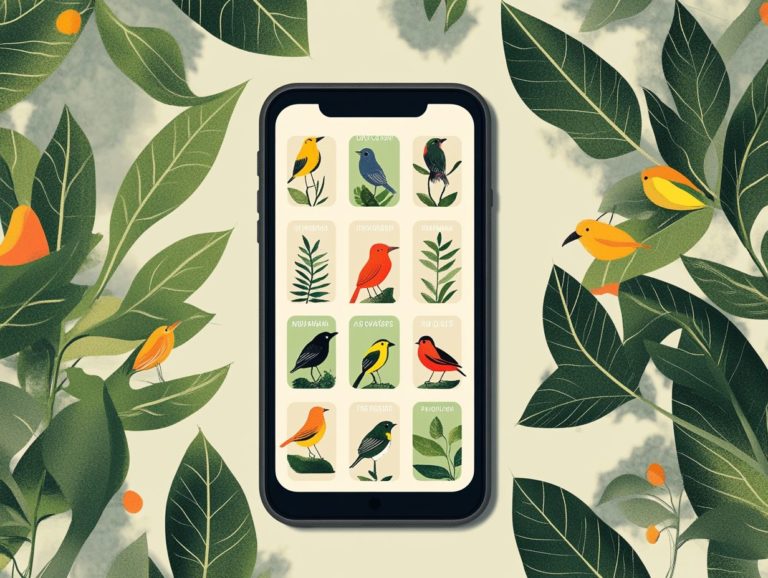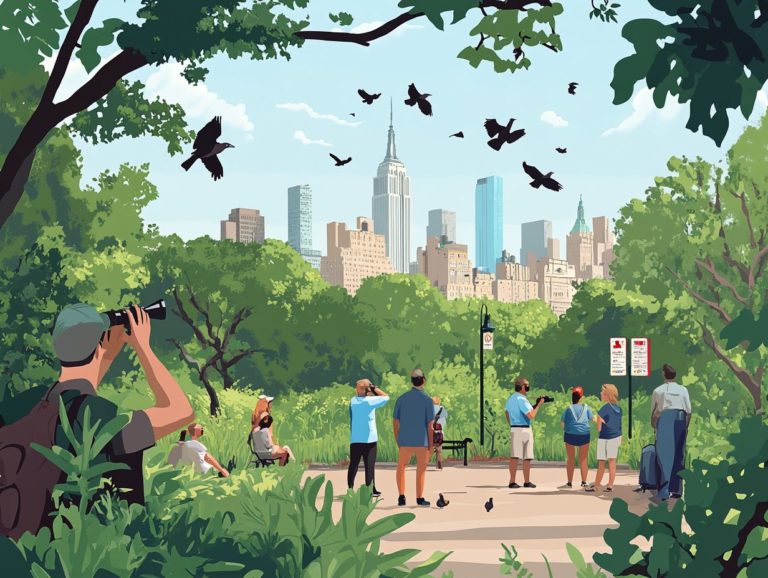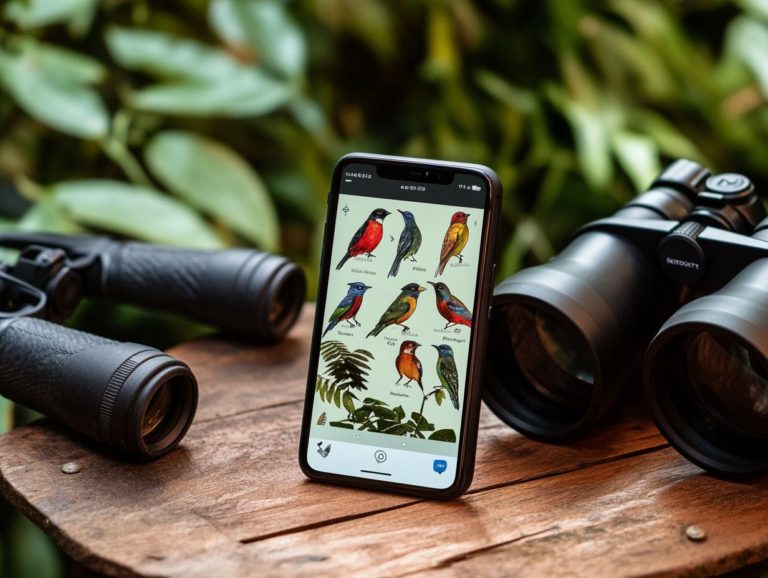The Role of Apps in Bird Habitat Protection
Birds play an essential role in nurturing healthy ecosystems, yet their habitats face mounting threats from both human actions and natural events.
Recognizing the significance of these habitats is vital for preserving biodiversity and maintaining ecological balance.
Fortunately, technology is rising to the occasion with innovative apps crafted specifically for the protection of bird habitats. These tools not only aid in mapping and monitoring critical areas but also actively engage communities in conservation efforts.
Explore ways you can participate and support these crucial initiatives.
Contents
- Key Takeaways:
- The Importance of Protecting Bird Habitats
- Threats to Bird Habitats
- The Role of Technology in Bird Habitat Protection
- Features and Functions of Bird Habitat Protection Apps
- Success Stories of Bird Habitat Protection Apps
- How to Get Involved in Bird Habitat Protection Through Apps
- Frequently Asked Questions
- What is the role of apps in bird habitat protection?
- How do apps help in monitoring bird populations?
- Are there apps specifically designed for bird habitat protection?
- Can apps be used to report illegal activities that harm bird habitats?
- How can apps help educate the public about bird habitat protection?
- Are there any benefits for bird habitat conservation organizations to use apps?
Key Takeaways:
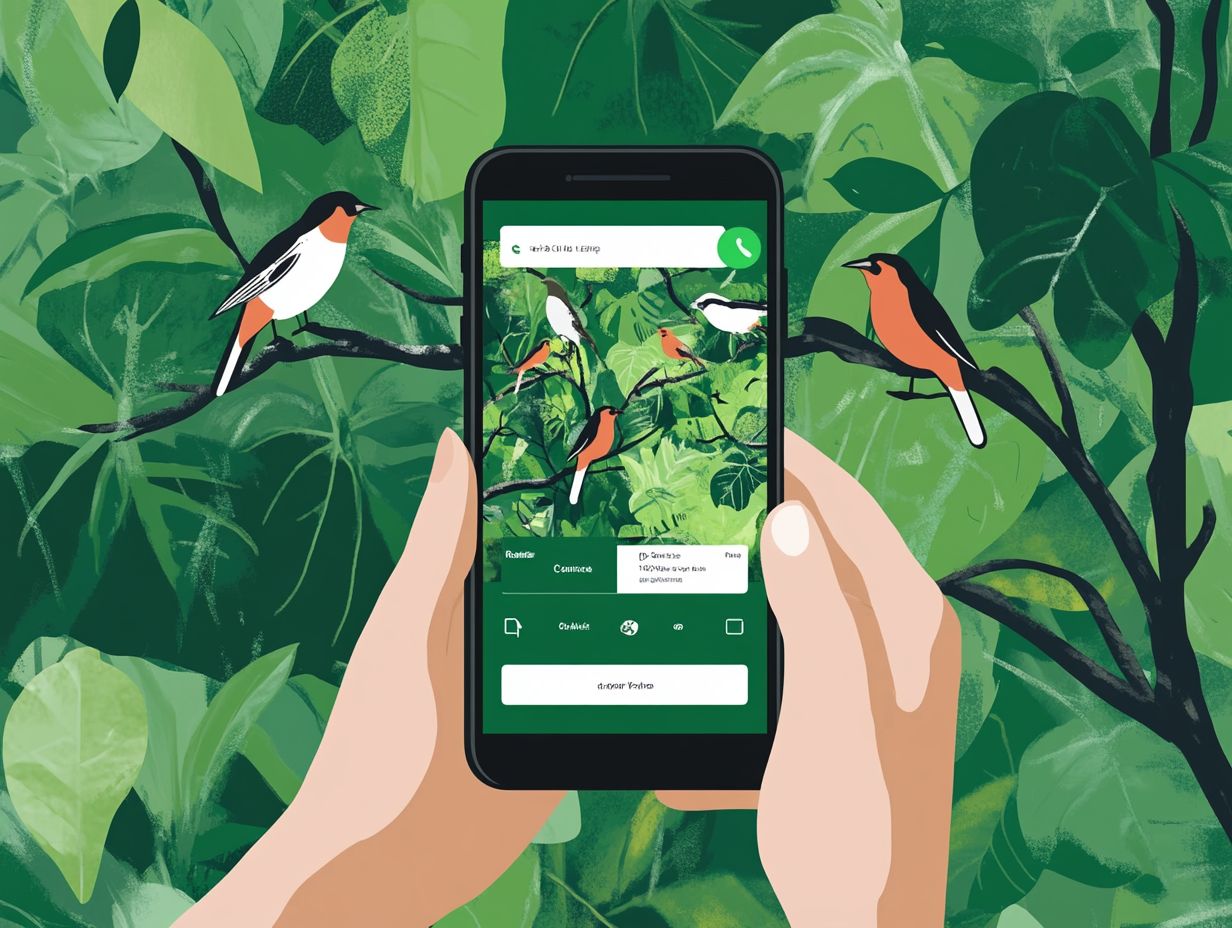
- Protecting bird habitats is crucial for maintaining ecosystem health and biodiversity.
- Human actions and natural causes pose significant threats to bird habitats, making conservation efforts essential.
- Bird habitat protection apps such as eBird and iNaturalist offer mapping and monitoring capabilities, education and citizen science opportunities, and have been successful in making a difference.
The Importance of Protecting Bird Habitats
Protecting bird habitats is essential not just for sustaining diverse bird populations and various bird species but also for maintaining the overall health of ecosystems. These habitats offer critical services like food production, water quality regulation, and carbon sequestration (the process of capturing and storing carbon dioxide to combat climate change), all of which are vital for biodiversity and the well-being of our natural world.
Your involvement in conservation efforts can make a significant difference in ensuring that these habitats are preserved and restored, particularly as human actions increasingly pose threats to these crucial ecosystems, impacting biodiversity and leading to habitat loss.
Why Bird Habitats are Essential for Ecosystems
Bird habitats are vital components of ecosystems, supporting not only avian species but also a wide array of other organisms that contribute to ecological balance, including various birding hotspots vital for migratory patterns.
These habitats deliver a wealth of ecosystem services crucial for sustaining natural processes and maintaining environmental health. For instance, birds play a critical role in pest control; many species actively hunt insects and other pests, which helps reduce reliance on chemical pesticides.
Birds also help with pollination, facilitating plant reproduction and supporting local biodiversity. Their role in seed dispersal is equally significant, aiding in the propagation of native flora and creating a vibrant network of vegetation that supports a multitude of other wildlife.
Monitoring bird populations helps researchers assess the overall health of the environment making it an essential indicator for conservation efforts. Ultimately, these dynamic interactions ensure that ecosystems remain resilient and vibrant.
Threats to Bird Habitats
Bird habitats confront a myriad of threats, both from human actions and natural forces. These challenges can result in substantial biodiversity loss and habitat destruction, placing numerous bird species at risk.
Your awareness of these issues is vital for fostering a deeper appreciation for avian conservation and the intricate balance of our ecosystems.
Join us in the fight to protect bird habitats! Your support is crucial to preserving our planet’s biodiversity.
Human Activities and Natural Causes
Human activities, such as urban development and industrial agriculture, along with natural factors like wildfires and climate change, significantly drive habitat destruction and biodiversity loss.
These actions often disrupt vital nesting areas and food sources, profoundly impacting bird populations and their seasonal abundance. For example, as cities expand, native species find themselves displaced. Intensive farming practices frequently lead to single crop farming (farms that grow only one type of crop), which cannot support diverse wildlife and harms wetland habitats, resulting in significant biodiversity loss.
Wildfires are worsened by rising temperatures and can devastate large landscapes, further reducing suitable habitats. Pollution from urban areas and agricultural runoff introduces harmful toxins into ecosystems, creating perilous conditions for avian species and posing challenges to wildlife management and habitat conservation efforts.
The combination of these human-induced pressures and natural threats creates a cascading effect, jeopardizing the fragile balance of ecosystems that birds depend on for survival.
The Role of Technology in Bird Habitat Protection

Technology significantly transforms bird habitat protection by enhancing your bird monitoring efforts, enabling real-time data collection, and leveraging AI technology for species identification and behavioral analysis. This facilitates community engagement and public awareness.
Overview of Bird Habitat Protection Apps
Bird habitat protection apps like eBird and Merlin Bird ID allow you to become an active participant in citizen science, which is when people like you help scientists gather important data. These platforms not only streamline the process of identifying and recording bird sightings but also invite you to play a crucial role in vital research efforts aimed at preserving avian populations.
With features such as location tracking, species identification guides, and community challenges, these apps empower you to engage in local conservation initiatives effortlessly. They often include social components, enabling you to connect with fellow enthusiasts, share your findings, and raise awareness about pressing environmental issues.
As a result, you deepen your investment in local ecosystems, contributing to a collective effort to safeguard habitats and bolster bird conservation initiatives.
Features and Functions of Bird Habitat Protection Apps
Bird habitat protection apps boast an array of features and functions designed to elevate data visualization and mapping. This enhances your ability to monitor bird populations with precision and actively participate in citizen science initiatives.
Mapping and Monitoring Capabilities
Mapping and monitoring capabilities offered by bird habitat protection apps empower you to track bird populations and visualize conservation data with remarkable clarity.
These tools are essential for grasping avian distribution patterns, enabling you, whether as a researcher or conservationist, to pinpoint critical habitats and monitor the health of various species in real time. By harnessing technology’s potential, you can gather invaluable insights that shape conservation strategies, ensuring interventions are finely tuned to the unique needs of different bird populations.
Continuous monitoring allows you to evaluate the impacts of environmental changes, such as habitat loss and climate change, enhancing the efficacy of your conservation planning. This data-driven approach encourages collaboration and promotes sustainable practices, ultimately contributing to healthier ecosystems where bird species can thrive.
Join us in protecting our feathered friends today!
Education and Citizen Science Opportunities
Bird habitat protection apps present an exceptional opportunity for education and citizen science. They allow you to refine your bird identification skills while actively contributing to conservation efforts.
These innovative platforms, including the Cornell Lab of Ornithology’s Bird Academy and BirdLife International, are not just a treasure trove of information about various bird species. They also help build a community by connecting you with fellow enthusiasts. You can share your observations and findings and engage in local projects that bolster bird conservation and habitat restoration.
The educational aspects of these apps often include interactive guides exploring bird behavior and ecology. You can learn about seasonal migrations, feeding habits, and nesting patterns, enriching your identification skills. By using these features, you can deepen your understanding of avian life while immersing yourself in initiatives that champion biodiversity and environmental stewardship.
Success Stories of Bird Habitat Protection Apps

Countless success stories, including those from initiatives like the Great Backyard Bird Count and Global Big Day, illustrate the profound impact that bird habitat protection apps have on conservation efforts. These apps empower community volunteers and citizen scientists to take action, effectively addressing habitat conservation challenges through real-time data, which means data that is collected and updated instantly.
Examples of Apps Making a Difference
Several applications, like eBird and Merlin Bird ID, have made remarkable strides in bird habitat protection, showcasing the transformative role of technology in conservation.
These apps are not just for bird identification; they allow you to report sightings and generate invaluable data that helps in understanding and monitoring bird populations. For instance, eBird users have contributed millions of observations, enabling scientists to track migratory patterns and pinpoint critical habitats that require protection.
Similarly, Merlin Bird ID uses advanced algorithms to assist you in identifying species through simple photos or audio recordings, making the experience more engaging. This encourages broader participation in local conservation efforts. Communities leveraging these applications often organize birding events and habitat restoration projects, forming a robust network of conservation advocates committed to protecting avian environments and enhancing community engagement.
How to Get Involved in Bird Habitat Protection Through Apps
Engaging in bird habitat protection through apps offers you an accessible and meaningful way to contribute to conservation efforts while connecting with the vibrant birding community.
Ways to Contribute and Support
You have many ways to support bird habitat protection initiatives, from joining citizen science projects to collaborating with local conservation organizations.
Take proactive steps by volunteering at nearby nature reserves, where you can play an active role in habitat restoration and maintenance efforts. Participate in organized data collection activities to foster a sense of community and provide invaluable information for researchers studying bird populations and behavior.
Support conservation organizations through donations or by raising awareness on social media. Adopt environmentally friendly practices at home, like cultivating bird-friendly gardens, to assist in preserving vital habitats.
Collectively, these efforts can greatly enhance the effectiveness of ongoing conservation initiatives.
Frequently Asked Questions
Join now to make a real difference in bird conservation! Download an app today and start contributing to bird conservation efforts!
What is the role of apps in bird habitat protection?
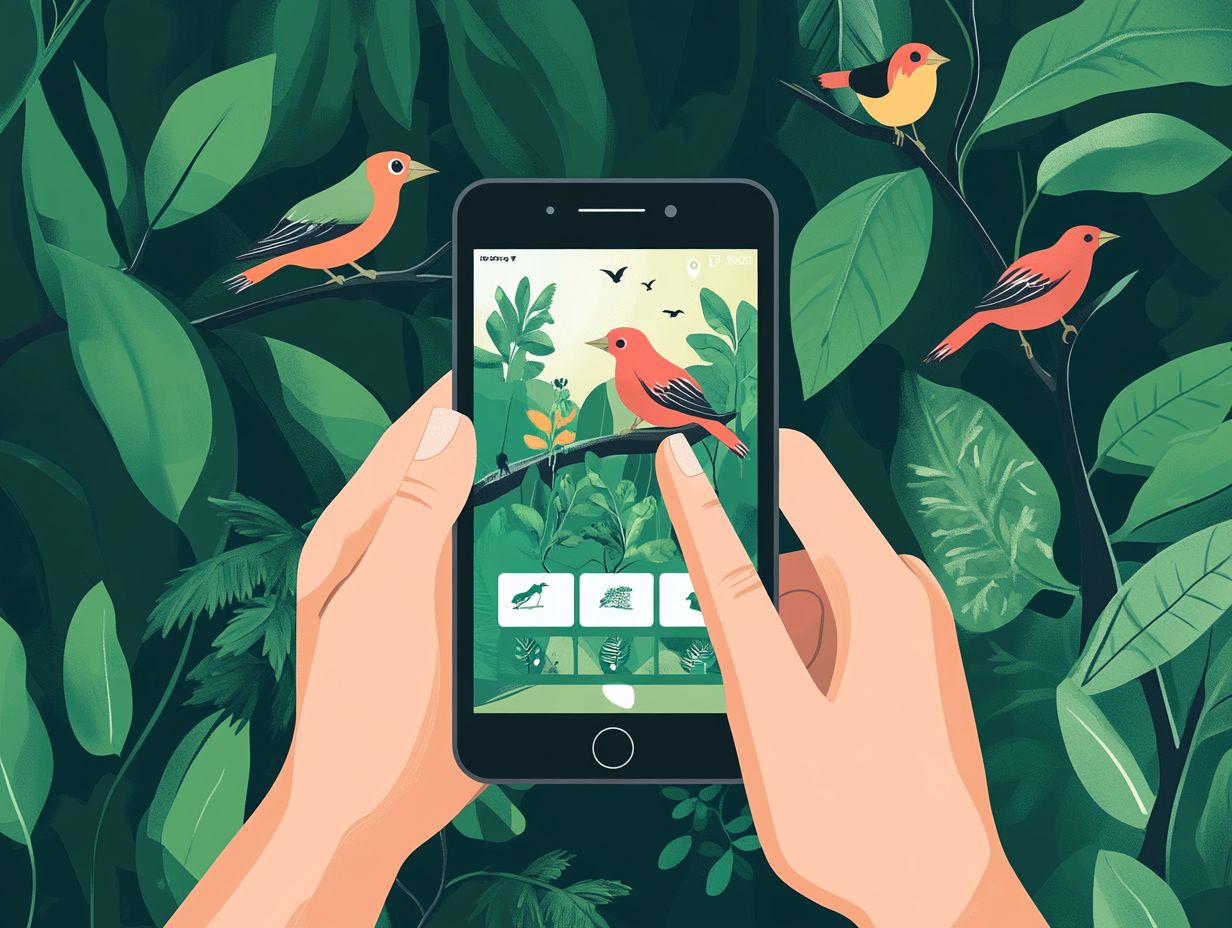
Apps play a crucial role in bird habitat protection. They provide easy access to information and resources for bird enthusiasts, including using apps to enhance your birdwatching skills for conservationists.
How do apps help in monitoring bird populations?
Apps collect and track data on bird sightings. This information is valuable for scientists studying bird populations.
Are there apps specifically designed for bird habitat protection?
Yes, many apps are specifically designed for bird habitat protection. Examples include bird identification guides and mapping tools.
Can apps be used to report illegal activities that harm bird habitats?
Yes, some apps allow users to report illegal activities. This includes poaching and habitat destruction, helping authorities take action.
How can apps help educate the public about bird habitat protection?
Apps offer easy-to-understand information and tools about bird habitats, and they delve into the science behind bird watching apps. They also provide resources on how individuals can help protect these ecosystems.
Are there any benefits for bird habitat conservation organizations to use apps?
Yes, apps help conservation organizations reach a wider audience. They also streamline data collection for their projects.

